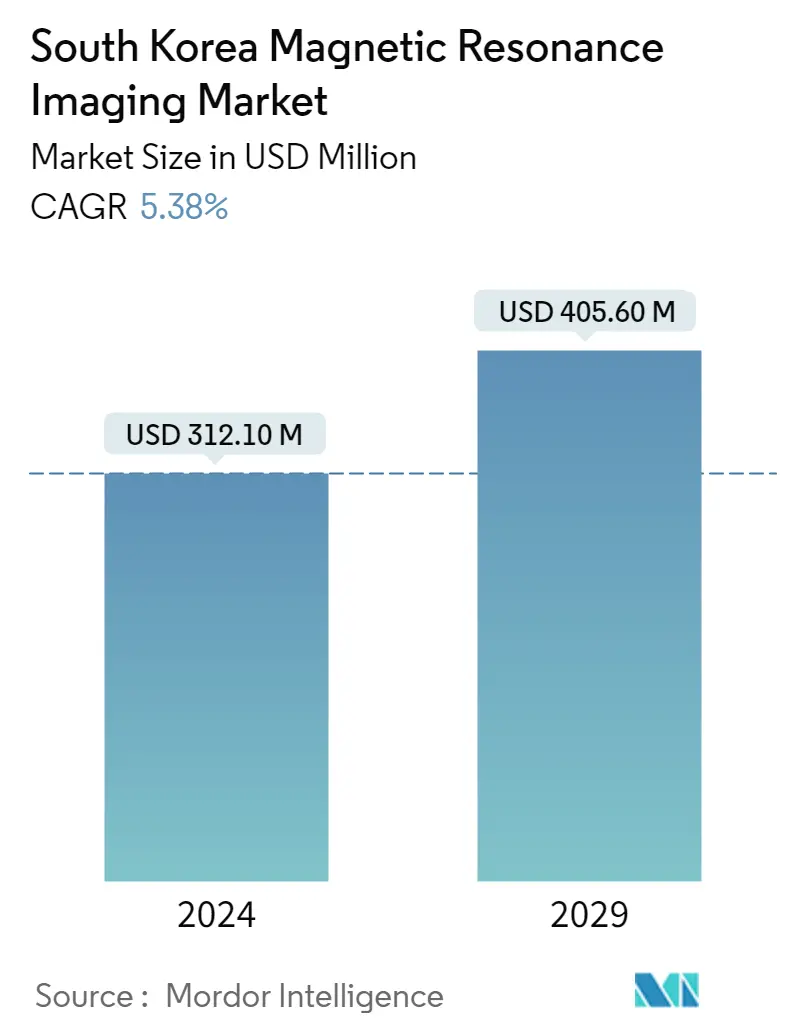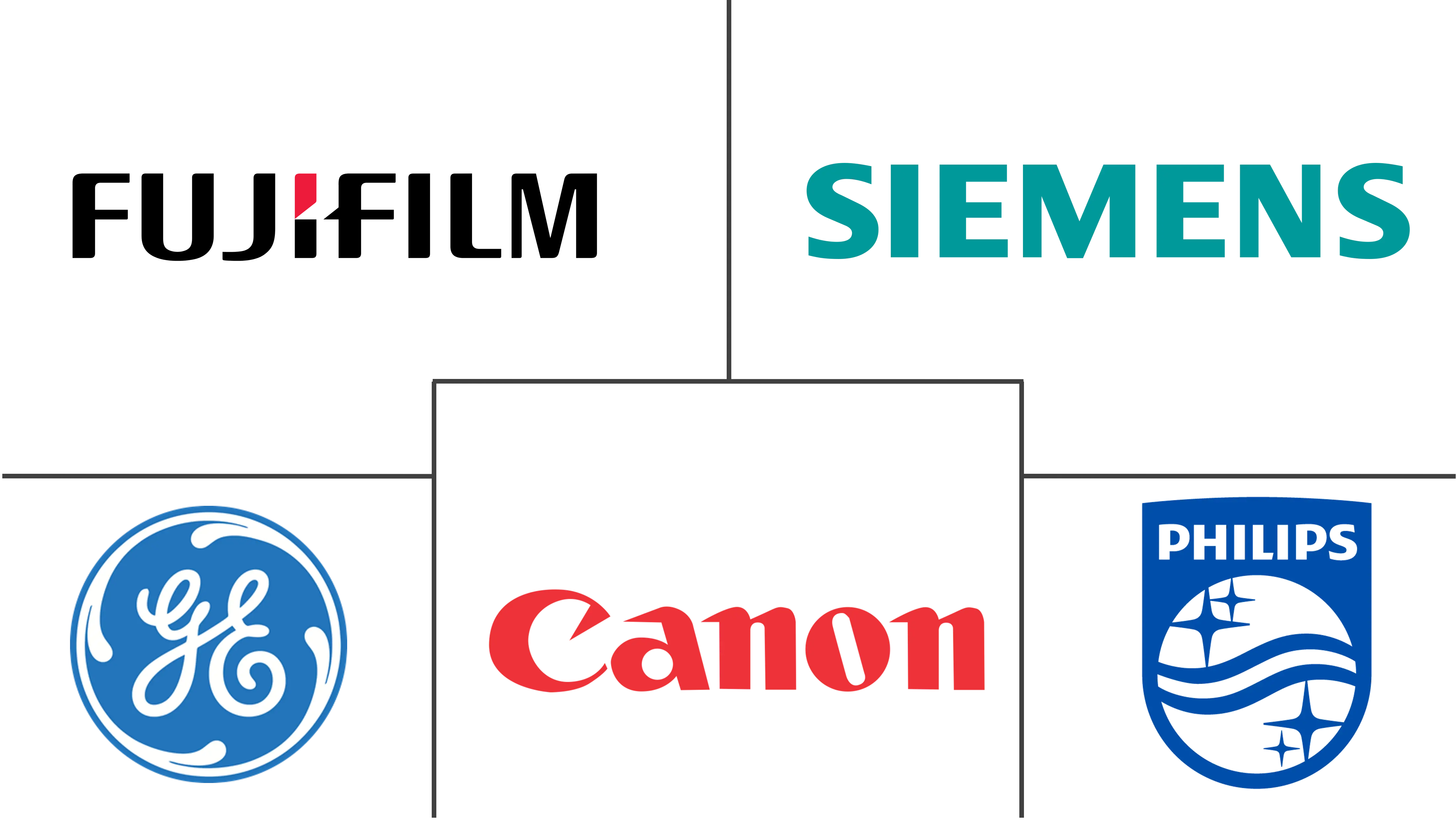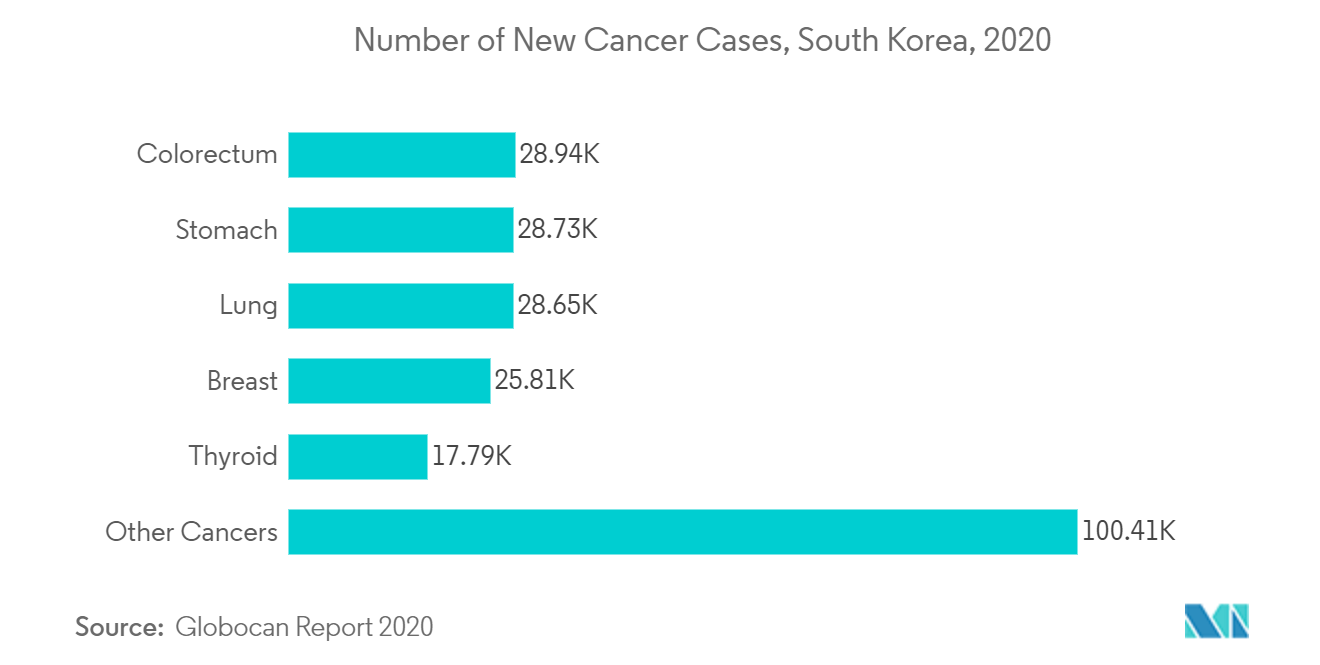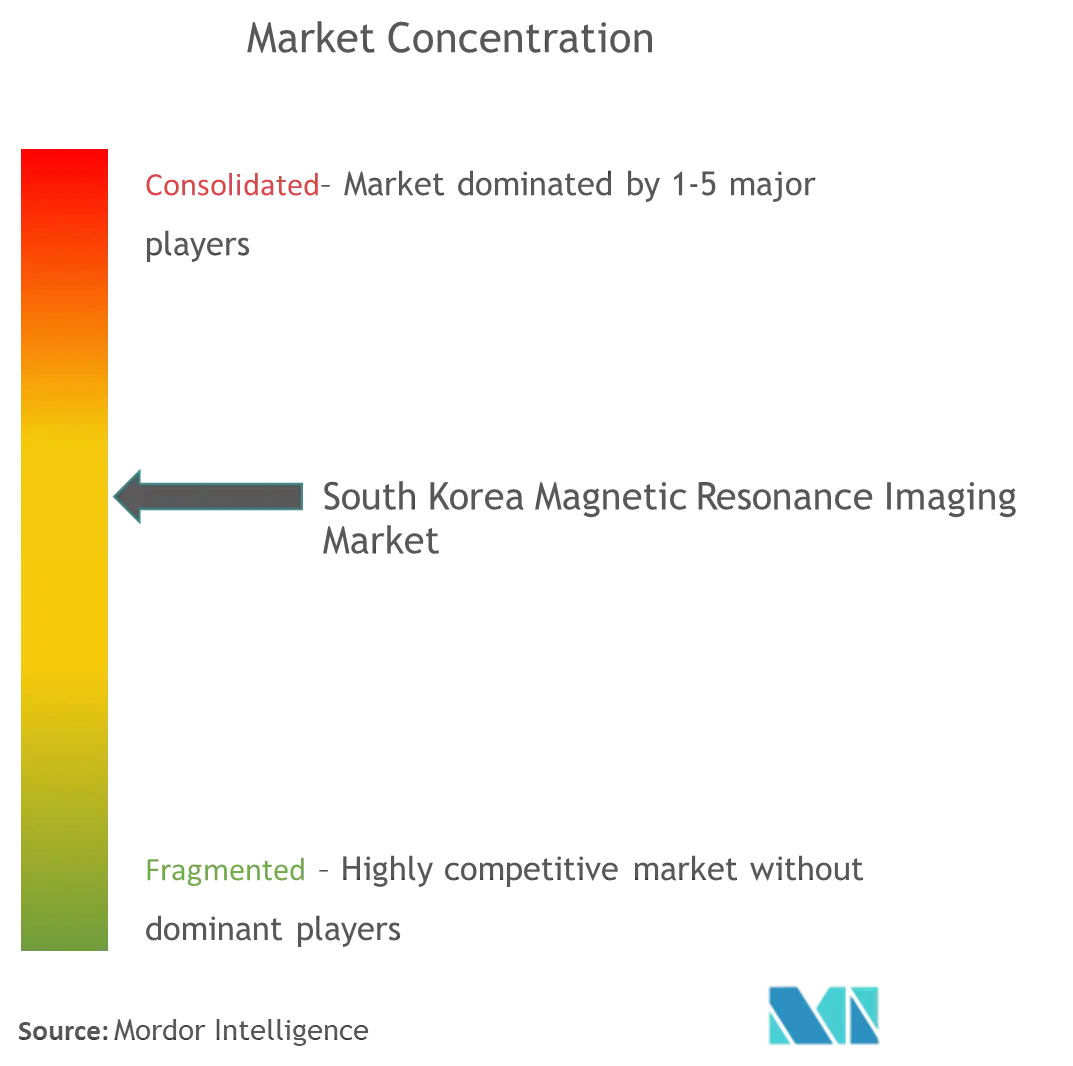South Korea Magnetic Resonance Imaging Market Size

| Study Period | 2019 - 2029 |
| Base Year For Estimation | 2023 |
| Market Size (2024) | USD 312.10 Million |
| Market Size (2029) | USD 405.60 Million |
| CAGR (2024 - 2029) | 5.38 % |
| Market Concentration | Medium |
Major Players
*Disclaimer: Major Players sorted in no particular order |
South Korea Magnetic Resonance Imaging Market Analysis
The South Korea Magnetic Resonance Imaging Market size is estimated at USD 312.10 million in 2024, and is expected to reach USD 405.60 million by 2029, growing at a CAGR of 5.38% during the forecast period (2024-2029).
The COVID-19 pandemic affected the market studied severely which was majorly due to the restrictions on non-emergency diagnostic procedures as a preventive major of coronavirus infection. As per an article published in March 2021, 'A critical juncture in universal healthcare: insights from South Korea's COVID-19 experience for the United Kingdom to consider,' the South Korean universal healthcare system, in particular, has been praised for its achievement in flattening the curve of confirmed COVID-19 cases. However, the pandemic has created stressful situations in the initial times. It created many adverse complications in patients. In some places, the lack of healthcare facilities caused difficulties in getting the right therapy. An MRI scan is used to track the progression of COVID-19 symptoms. Neurologic manifestations of COVID-19 are associated with MRI scans of abnormal brains and symptoms of anosmia, partial loss of sense of smell, or changes in taste in a patient with a severe case of COVID-19. Likewise, there are many effects associated with COVID-19 infection reviewed theoretically and practically. Most of them needed MRI imaging to identify the possible changes. Hence, with the use of MRI in South Korea in understanding the adverse effects of COVID-19 on other organs, the market studied was witnessing a gradual rate of growth during the years 2020 and 2021. However, the market is gaining pace currently as there has been a surge in elective diagnostics or procedures.
The major factors that are expected to drive the growth of the magnetic resonance imaging (MRI) market in South Korea include the presence of a large geriatric population, advanced healthcare infrastructure, and new product launches in the country. Furthermore, increasing prevalence and burden of chronic diseases is fueling the market growth in South Korea. For instance, As per the article titled 'Health-economic burden of dementia in South Korea' published by BMC in October 2021, the prevalence of dementia in Korea in the year 2020 was 10.25% among those aged 65 and above which accounted for around 8,30,000 people. It is anticipated to rise to nearly 15.91% by 2050, with a population of 3.02 million suffering from dementia. Thus, increasing cases of dementia in the future will create the demand for MRI scans in the country and will contribute to the market growth.
South Korea Magnetic Resonance Imaging Market Trends
This section covers the major market trends shaping the South Korea Magnetic Resonance Imaging Market according to our research experts:
High-Field MRI Systems are Expected to Witness Healthy Growth Over the Forecast Period
Technological advancements in high-field MRI scanners are expected to drive the growth of high-field MRI scanners in this region. For instance, in 2021, Elekta Korea launched their Elekta Unity radiation treatment system, which combines magnetic resonance imaging and a linear accelerator. Philips' high-resolution 1.5 teslas (T) MRI scanner and seven-megavolt linear accelerator are combined in the Elekta Unity. It delivers high-resolution MRI scans incorporating patients' anatomy and biological information, enabling tailored radiation therapy based on tumor characteristics.
The rising adoption of high-field MRI scanners in South Korea is also expected to propel the market growth for this segment. For instance, in 2020, Vantage Elan, a high-tech 1.5 Tesla magnetic resonance imaging (MRI) system from Canon Medical Systems Korea, was installed at Sesonneun Orthopedic Hospital in Korea to get super-precise imaging of the spine and joint.
The development of Magnetic Resonance (MR) software by local startup companies in South Korea is contributing to the surge in the high-field MRI scanners market. For instance, in the year 2021, AIRS Medical Inc., a South Korean healthcare firm, received the Food and Drug Administration approval for its initial product SwiftMR. It is an AI-powered MRI reconstruction program that improves MR images recorded under a variety of situations, resulting in increased throughput and improved patient experience.
Hence, the above developments in high-field MRI systems, it is expected to drive market growth.

South Korea Magnetic Resonance Imaging Industry Overview
The South Korea magnetic resonance imaging market is highly competitive and consists of several major players. In terms of market share, a few of the major players currently dominate the market. However, with technological advancements and quality service provisions, mid-size to smaller companies are increasing their market presence by introducing new products at less prices. Companies, like Siemens Healthineers, GE Healthcare, Canon Medical Systems, and Philips Healthcare, hold a significant market share in the magnetic resonance imaging market.
South Korea Magnetic Resonance Imaging Market Leaders
-
Siemens AG
-
Canon Medical Systems
-
GE Healthcare
-
Fujifilm Holdings Corporation
-
Koninklijke Philips NV
*Disclaimer: Major Players sorted in no particular order

South Korea Magnetic Resonance Imaging Market News
- In August 2022, South Korea-based healthcare start-up AIRS Medical has secured around USD 20 million in a Series B funding round that included existing investor Klim Ventures.
- In February 2021, Elektra launched its next-generation 1.5T MRI device called Unity in South Korea.
South Korea Magnetic Resonance Imaging Market Report - Table of Contents
1. INTRODUCTION
- 1.1 Study Assumptions and Market Definition
- 1.2 Scope of the Study
2. RESEARCH METHODOLOGY
3. EXECUTIVE SUMMARY
4. MARKET DYNAMICS
- 4.1 Market Overview
-
4.2 Market Drivers
- 4.2.1 Introduction of Hybrid MRI Systems
- 4.2.2 Increasing Prevalence of Chronic Diseases and Rising Geriatric Population
-
4.3 Market Restraints
- 4.3.1 High Cost of MRI Systems
-
4.4 Porter's Five Forces Analysis
- 4.4.1 Threat of New Entrants
- 4.4.2 Bargaining Power of Buyers/Consumers
- 4.4.3 Bargaining Power of Suppliers
- 4.4.4 Threat of Substitute Products
- 4.4.5 Intensity of Competitive Rivalry
5. MARKET SEGMENTATION (Market Size by Value - USD million)
-
5.1 By Architecture
- 5.1.1 Closed MRI Systems
- 5.1.2 Open MRI Systems
-
5.2 By Field Strength
- 5.2.1 Low Field MRI Systems
- 5.2.2 High Field MRI Systems
- 5.2.3 Very High Field MRI Systems and Ultra-high MRI Systems
-
5.3 By Application
- 5.3.1 Oncology
- 5.3.2 Neurology
- 5.3.3 Cardiology
- 5.3.4 Gastroenterology
- 5.3.5 Musculoskeletal
- 5.3.6 Other Applications
6. COMPETITIVE LANDSCAPE
-
6.1 Company Profiles
- 6.1.1 Canon Medical Systems Corporation
- 6.1.2 Fujifilm Holdings Corporation
- 6.1.3 GE Healthcare
- 6.1.4 Koninklijke Philips NV
- 6.1.5 Siemens Healthineers
- 6.1.6 Esaote SpA
- 6.1.7 Neusoft Medical Systems Co. Ltd
- 6.1.8 Fonar Corporation
- 6.1.9 Medonica Co. Ltd
- *List Not Exhaustive
7. MARKET OPPORTUNITIES AND FUTURE TRENDS
** Subject To AvailablitySouth Korea Magnetic Resonance Imaging Industry Segmentation
As per the scope of this report, Magnetic resonance imaging is a medical imaging technique, which is used in radiology to produce pictures of the anatomy and the physiological processes of the body. These pictures are further used to diagnose and detect the presence of abnormalities in the body. South Korea Magnetic Resonance Imaging (MRI) Market is segmented by Architecture (Closed MRI Systems and Open MRI Systems), Field Strength (Low Field MRI Systems, High Field MRI Systems, Very High Field MRI Systems, and Ultra-high MRI Systems), Application (Oncology, Neurology, Cardiology, Gastroenterology, Musculoskeletal, and Other Applications). The report offers the value (in USD million) for the above segments.
| By Architecture | Closed MRI Systems |
| Open MRI Systems | |
| By Field Strength | Low Field MRI Systems |
| High Field MRI Systems | |
| Very High Field MRI Systems and Ultra-high MRI Systems | |
| By Application | Oncology |
| Neurology | |
| Cardiology | |
| Gastroenterology | |
| Musculoskeletal | |
| Other Applications |
South Korea Magnetic Resonance Imaging Market Research FAQs
How big is the South Korea Magnetic Resonance Imaging Market?
The South Korea Magnetic Resonance Imaging Market size is expected to reach USD 312.10 million in 2024 and grow at a CAGR of 5.38% to reach USD 405.60 million by 2029.
What is the current South Korea Magnetic Resonance Imaging Market size?
In 2024, the South Korea Magnetic Resonance Imaging Market size is expected to reach USD 312.10 million.
Who are the key players in South Korea Magnetic Resonance Imaging Market?
Siemens AG, Canon Medical Systems, GE Healthcare, Fujifilm Holdings Corporation and Koninklijke Philips NV are the major companies operating in the South Korea Magnetic Resonance Imaging Market.
What years does this South Korea Magnetic Resonance Imaging Market cover, and what was the market size in 2023?
In 2023, the South Korea Magnetic Resonance Imaging Market size was estimated at USD 296.17 million. The report covers the South Korea Magnetic Resonance Imaging Market historical market size for years: 2019, 2020, 2021, 2022 and 2023. The report also forecasts the South Korea Magnetic Resonance Imaging Market size for years: 2024, 2025, 2026, 2027, 2028 and 2029.
South Korea Magnetic Resonance Imaging Industry Report
Statistics for the 2024 South Korea Magnetic Resonance Imaging market share, size and revenue growth rate, created by Mordor Intelligence™ Industry Reports. South Korea Magnetic Resonance Imaging analysis includes a market forecast outlook 2029 and historical overview. Get a sample of this industry analysis as a free report PDF download.



